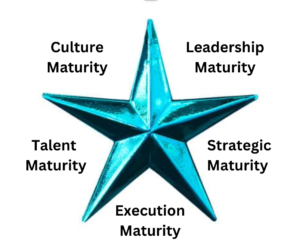
The Five Maturities Framework stands as a cornerstone in the realm of organizational development and transformation. This innovative concept offers a comprehensive and structured methodology, enabling organizations to evaluate their maturity and evolution across five pivotal dimensions. By delving into these key areas, the framework provides invaluable insights into an organization’s current state and its readiness for growth and transformation. Through meticulous assessment and analysis, leaders can gain a deeper understanding of their organization’s strengths, weaknesses, and opportunities for improvement, laying the groundwork for strategic decision-making and targeted interventions. With its holistic approach and actionable insights, the Five Maturities Framework serves as a guiding beacon for organizations navigating the complexities of modern business landscapes, empowering them to evolve, adapt, and thrive in an ever-changing world.

- Leadership Maturity: This dimension evaluates the leadership’s ability to set a clear vision, inspire and motivate employees, make strategic decisions, and foster a culture of trust, accountability, and innovation.
- Vision and Inspiration: Effective leaders have a clear vision for the organization’s future and can inspire and motivate employees to work towards that vision.
- Strategic Decision-Making: They make informed strategic decisions based on data, market analysis, and insights into industry trends.
- Culture Building: Leaders cultivate a culture of trust, transparency, accountability, and innovation, where employees feel empowered to contribute their best.
- Change Management: They adeptly manage change and navigate challenges, fostering resilience and adaptability within the organization.
- Strategy Maturity: Strategy maturity focuses on the organization’s ability to develop and execute effective strategies aligned with its vision and goals. It involves aspects such as strategic planning, market analysis, resource allocation, and risk management.
- Strategic Planning: The organization engages in robust strategic planning processes to define its mission, vision, goals, and objectives.
- Alignment: Strategies are aligned with the organization’s mission and goals, as well as with market dynamics and competitive landscape.
- Execution Planning: Detailed plans are developed to execute strategies effectively, including resource allocation, timelines, and performance metrics.
- Risk Management: Risks are identified, assessed, and managed to mitigate potential threats and seize opportunities.
- Execution Maturity: Execution maturity refers to how effectively the organization translates its strategies into action. It involves areas such as project management, process improvement, performance measurement, and operational efficiency.
- Project Management: Projects and initiatives are managed efficiently, with clear goals, timelines, and accountability structures.
- Process Improvement: Continuous improvement methodologies, such as Lean or Six Sigma, are used to optimize processes and enhance operational efficiency.
- Performance Measurement: Key performance indicators (KPIs) are defined and tracked to monitor progress and ensure alignment with strategic objectives.
- Operational Excellence: The organization focuses on delivering high-quality products or services while minimizing waste and maximizing value to customers.
- Talent Maturity: Talent maturity assesses the organization’s ability to attract, develop, and retain top talent. It includes aspects such as recruitment, training and development, succession planning, employee engagement, and diversity and inclusion initiatives.
- Recruitment and Selection: Effective recruitment processes are in place to attract top talent that aligns with the organization’s values and goals.
- Training and Development: Ongoing training and development programs help employees build skills, knowledge, and capabilities to perform their roles effectively.
- Succession Planning: Plans are developed to identify and groom future leaders, ensuring continuity and stability within the organization.
- Employee Engagement: Strategies are implemented to foster a positive work environment, promote employee satisfaction, and enhance retention rates.
- Diversity and Inclusion: The organization values diversity and fosters an inclusive culture where all employees feel respected, valued, and empowered to contribute.
- Culture Maturity: Culture maturity examines the values, beliefs, and behaviors that shape the organization’s culture. It includes factors such as communication, collaboration, teamwork, adaptability, and resilience.
- Communication: Open, transparent communication channels exist throughout the organization, fostering collaboration and alignment.
- Collaboration and Teamwork: Cross-functional collaboration and teamwork are encouraged to drive innovation and problem-solving.
- Adaptability: The organization is agile and adaptable, able to respond quickly to changes in the external environment.
- Resilience: Employees demonstrate resilience in the face of challenges, learning from setbacks and continuously improving.

By evaluating the organization’s maturity level across these five dimensions, leaders can identify strengths, weaknesses, and areas for improvement. This framework provides a roadmap for driving organizational development and transformation initiatives to enhance overall performance and competitiveness.